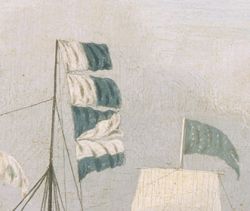loading 
Fitz Henry Lane
HISTORICAL ARCHIVE • CATALOGUE RAISONNÉ • EDUCATIONAL RESOURCE
An online project under the direction of the CAPE ANN MUSEUM
An online project under the direction of the CAPE ANN MUSEUM
Catalog entry
inv. 49
The "Britannia" Entering Boston Harbor
1848 Oil on panel 14 3/4 x 19 3/4 in. (37.5 x 50.2 cm) Initialed lower left: FHL
|
Related Work in the Catalog
Supplementary Images
Provenance (Information known to date; research ongoing.)
Vose Galleries, by 1980
Norma and Roger Alfred Saunders, 1980
Museum of Fine Arts, Boston, 2000
Exhibition History
National Gallery of Art, Washington, District of Columbia, Paintings by Fitz Hugh Lane, May 15–September 5, 1988., no. 30, ill. in color, 57, The "Britannia" Entering Boston Harbor.
Traveled to: Museum of Fine Arts, Boston, Mass., 5–31, 1988.
Traveled to: Museum of Fine Arts, Boston, Mass., 5–31, 1988.
Published References
Wilmerding, John. Paintings by Fitz Hugh Lane. Washington, DC: National Gallery of Art; in association with Harry N. Abrams, 1988., ill. in color p. 57, cat.30.
Wilmerding, John. Fitz Henry Lane. Gloucester, MA: Cape Ann Historical Association, 2005. Reprint of Fitz Hugh Lane, by John Wilmerding. New York: Praeger, 1971. Includes new information regarding the artist's name.
Craig, James. Fitz H. Lane: An Artist's Voyage through Nineteenth-Century America. Charleston, SC: The History Press, 2006., pl. 13.

Commentary
This picture has long been thought to depict the arrival of British steamship "Britannia" in Boston Harbor in 1840, however the signal flags displayed by the vessel indicate that although it is part of the same Britannia class as the steamship "Britannia," it is actually a ship named the "Caledonia."
The important event of the arrival of the "Britannia" in 1840 established a strong commercial link with Great Britain, and made Boston the major American port for the transmission of mail and cargo to and from Europe. Steamships were familiar sights to Bostonians by this time, but it was noteworthy to see such an important vessel.